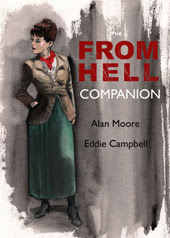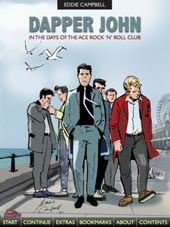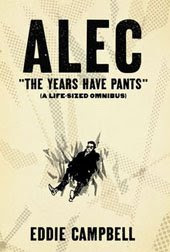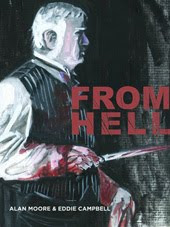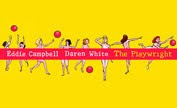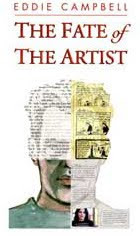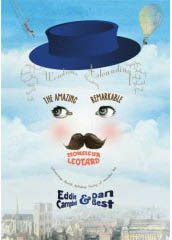Saturday, 28 March 2009
Friday, 27 March 2009
still beating the Big Numbers thing to death. The Al Columbia component has always been a mystery, but I just recalled this image I filed sometime last year, I think (i didn't date it). Rick Bradford of Poopsheet was selling this small original on Ebay. He wrote:
Note that the image clearly has a British setting and is stylistically consistent with what we've already seen.
***********
UPDATE
Bill Anderson in comments mentions that the multi-generational photocopies don't convey accurately the abrupt stylistic change between issues 2 and 3 of Big Numbers. And my fellow artist Sean Phillips correctly observed "In fact those scans look more like the halftoning you used to get on faxes of greyscale images." It got me to casting around the net for some shots of the originals. There is a nice gallery of several pages here. Whether these are original art or good photographs i don't know, but they make enough of a contrast with the photocopies to be revealing:




"I believe this single panel either would have appeared in issue #4 of Alan Moore's Big Numbers or it was abandoned/redrawn before the final artwork was completed. The second possibility is probably more likely. Either way, #4 was never published and the final artwork was destroyed so perhaps we'll never know for sure.
What I am certain of is that this panel was drawn by Columbia and intended for Big Numbers.
The dimensions are roughly 3¾ × 5". The media appears to be pencil, black ink and opaque white ink on bristol board."

Note that the image clearly has a British setting and is stylistically consistent with what we've already seen.
***********
UPDATE
Bill Anderson in comments mentions that the multi-generational photocopies don't convey accurately the abrupt stylistic change between issues 2 and 3 of Big Numbers. And my fellow artist Sean Phillips correctly observed "In fact those scans look more like the halftoning you used to get on faxes of greyscale images." It got me to casting around the net for some shots of the originals. There is a nice gallery of several pages here. Whether these are original art or good photographs i don't know, but they make enough of a contrast with the photocopies to be revealing:




Labels: Big Numbers
BIG NUMBERS. Further reading:
Alan Moore, 2000, interview at Blather.net
I missed this at Slate.com: Watchmen Failed
The revolution it was supposed to inspire—comics about ordinary people—never happened.
By Grady Hendrix
Posted Thursday, March 5, 2009,
Bill Anderson in comments yesterday contributed this note:
Frank Santoro's post on the subject from last August, like most of his writing, tells us more about Santoro than about his subject
"Reading it feels like trying to make your way through a crowded funeral parlor."
However, Robert Stanley Martin's assessment from last september, written in response to Santoro, is very good:
I've noticed that more than one commentator has attributed the third Big Numbers entirely to AlColumbia. NOT TRUE.
I was checking the Wikipedia page for Big Numbers and was amused to see that it sends readers to How to be an Artist for "a thinly fictionalized version' of events." arf ("we'll fix that when we get home, Bart")
Alan Moore, 2000, interview at Blather.net
"Yeah, well, I mean, I've got the whole thing plotted. I've got an enormous sheet of A1 paper with the whole plot on it, almost like a graph. The idea was that we were going to produce a really good comic, publish it ourselves, we were really committed to it and it was my money that was kind of supporting the entire thing. What happened was that Bill Sienkiewicz, after promising to do it, he did a brilliant job on the first two episodes and then just seemed to stop working upon it and all the money was kind of pouring down a black hole, because we'd still got overheads but we couldn't actually get a comic out, because the artist wouldn't - and we kept saying "Look, Bill, if you don't want to do this work, just tell us and we'll think about something else, get a replacement in or something but just tell us so that we're not just having all of our money pouring down a drain" and Bill still didn't get up the nerve to tell us that he didn't want to do it for another few months, by which time our situation was desperate. Then Kevin Eastman, of Teenage Mutant Ninja Turtles fame, he stepped in with his brave but doomed publishing venture Tundra and he was trying to produce Big Numbers. We tried to get Al Columbia, who'd been Bill Sienkiewicz's assistant, to continue with the strip. Now, I heard that Al did an issue of it but then, depending on which story to believe, either he destroyed the artwork or took it away or I don't know what happened but it meant that we'd had two artists sort of back out on the project.
I don't see any way that I can resurrect it as a comic strip. I mean, what do I do? Do I actually sort of say "Yeah, we've got a great new artist, are we going to start from #1 again but this time, no, buy it, because this time we really will get to issue #12." I mean, I wouldn't buy that if I heard it from somebody who'd kind of failed twice to do what he said he was going to do. "
I missed this at Slate.com: Watchmen Failed
The revolution it was supposed to inspire—comics about ordinary people—never happened.
By Grady Hendrix
Posted Thursday, March 5, 2009,
"artistically, Watchmen came and went, and the promised revolution in comic-book storytelling never happened. The comic was written by Alan Moore and drawn by Dave Gibbons, and became to comic books what The Sopranos is to TV: an intellectual fig leaf concealing the vast wasteland of Two and a Half Men reruns.
A fourth dimension is opened up when a comic book about pirates being read by the freeloading kid at the newsstand becomes part of the narrative, amplifying and commenting on the action. Visual details linger from scene to scene, linking disparate locations and characters; conversations started by one character are finished by another; and every detail, every image, every sentence seems to contain the entire DNA of the story. There is no center because it's all center. The lurid violence of the superhero plotline is overshadowed by truly heroic acts of forgiveness, selflessness, and the facing of hard truths by characters who would normally barely merit a glance in an issue of Batman. Needless to say, most of these characters and techniques are missing from the finished film, which views Watchmen from only the superhero fan point of view, which is the least rewarding approach.
After Watchmen, Alan Moore attempted the most ambitious comic book of his career, Big Numbers. A miniseries in roughly the same format as Watchmen, it would completely avoid superheroes (whom Moore describes as "a bit morally simplistic") and instead focus on the residents of a small British town thrown into disarray when an American shopping center opens in its midst..."
Bill Anderson in comments yesterday contributed this note:
'Though by the time you asked him about it the reason for not publishing #3 has become (the more diplomatic) that it doesn't make sense to publish #3 without a #4 through #12, you actually mention the real (or at least original) reason for not publishing: The radical style change in the midst of #3.
I was in the offices within a few days of the arrival of the duotone pages, and Kevin showed them to me. I don't have a recording of what was said, and I didn't take notes, so let me just say that my impression of his reaction was 'Can you fucking believe this? There's no way we're publishing this.'
Frank Santoro's post on the subject from last August, like most of his writing, tells us more about Santoro than about his subject
"Reading it feels like trying to make your way through a crowded funeral parlor."
However, Robert Stanley Martin's assessment from last september, written in response to Santoro, is very good:
"Restraint is not a tendency I associate with Sienkiewicz, and the project's demand for it on his part may be why he burned out on it so quickly. He and Moore are not natural collaborators. Despite Moore's claims that he shapes each project in accord with the artist's strengths, he inevitably treats an artist he works with as a pair of hands. The legendary degree of detail he includes in his scripts can easily serve to intimidate. Sienkiewicz's nature favors eclecticism and spontaneity; his first impulse is to experiment. He needs the sort of collaborator he had with Frank Miller on Elektra: Assassin and Daredevil: Love and War: someone he can bounce ideas off of, and who treats him as an equal when it comes to shaping (or changing) a work's direction. He's the sort who would chafe under the taskmaster scripts of a writer like Moore. It would have been a miracle for a project like Big Numbers, with its expected length of 500 pages, to not go off the rails with these two, and a miracle didn't happen.
I've noticed that more than one commentator has attributed the third Big Numbers entirely to AlColumbia. NOT TRUE.
I was checking the Wikipedia page for Big Numbers and was amused to see that it sends readers to How to be an Artist for "a thinly fictionalized version' of events." arf ("we'll fix that when we get home, Bart")
Labels: "We'll fix that when we get home Bart", alan moore, Big Numbers
Thursday, 26 March 2009
this is an important event. I don't know the whole story of who did it yet, but the entire unpublished third issue of Big Numbers has been cobbled together. I recall asking publisher Kevin Eastman at the time why, even though the 12-issue series was abandoned, he couldn't put out the existing third issue. He looked at me as though I was daft. Who would want a third issue if they knew there wouldn't be any after that? Given the number of unexplainables he had already published, and the millions of dollars squandered, I couldn't follow his logic.
Photocopies of the pages have been going around for quite some time. I obtained an incomplete set from a purchaser of some of the artwork a long time ago. But even between this and filling in some spaces later, i only have 28 of the 40 pages. Add to that that even though the script also exists, nobody has ever taken the trouble to letter it onto copies of the pages. Until now. And the quality is good, or at least far superior to the copies i already have.You can see it in hi-res at Flickr.

The legend is that this was the last issue that Bill Sinkiewicz completed, with young Al Columbia assisting. Bill then dropped the project and Al allegedly drew a fourth issue, but his head imploded and he destroyed it. You can't make up stuff like that. I drew a detailed account of this muddle in my How to be an Artist, with no mercy for any of the participants. It's currently out of print but will be contained in The Alec Omnibus, due out in September. I've also added a new 2-page postscript to that story.
Bill changed the style considerably on the third issue, shifting the technique from grey wash and gouache to doubletone board, presumably to move things along quicker. Any attempt to see Columbia's hand in the technical change would be wrong, as Sinkiewicz tended to change his approaches just out of restlessness. And since Al got the job as he was able to imitate Bill's style, to try to ascribe this or that part of the job to him would be a waste of mental effort.
It's funny. Or sad. While reading it I felt that I was in 1992 and the fourth issue could be expected in June approximately. I was looking forward to it and had to stand back and remind myself it isn't coming. not ever.
Another thing I remembered, and I don't think I ever mentioned it to Alan, but I always felt a certain resentment that Billy the Sink got Big Numbers and blew it while i was stuck drawing Jack the bloody Ripper for ten years (I once described it as a penny dreadful that costs thirty five bucks). I stand by my opinion that Big Numbers was the superior idea and would have been Alan's masterpiece. Of course it is also true that Sinkiewicz is a world class illustrator and there's no way I could have done a job that complicated in 1992. I could have taken a crack at it later (post-Birth Caul/Snakes and Ladders), and offered, but Alan wasn't up for that. I love the ease with which Bill shifts from photographic mode to outright loony tunes. The separated Gathercoles remembering their courtship and early marriage is a masterstroke (pages 19-21). That's an odd note at the bottom of page 29 where he slips back into his Moon Knight style.
All we can hope for now is for a xerox of destroyed fourth issue to turn up.
Photocopies of the pages have been going around for quite some time. I obtained an incomplete set from a purchaser of some of the artwork a long time ago. But even between this and filling in some spaces later, i only have 28 of the 40 pages. Add to that that even though the script also exists, nobody has ever taken the trouble to letter it onto copies of the pages. Until now. And the quality is good, or at least far superior to the copies i already have.You can see it in hi-res at Flickr.

The legend is that this was the last issue that Bill Sinkiewicz completed, with young Al Columbia assisting. Bill then dropped the project and Al allegedly drew a fourth issue, but his head imploded and he destroyed it. You can't make up stuff like that. I drew a detailed account of this muddle in my How to be an Artist, with no mercy for any of the participants. It's currently out of print but will be contained in The Alec Omnibus, due out in September. I've also added a new 2-page postscript to that story.
Bill changed the style considerably on the third issue, shifting the technique from grey wash and gouache to doubletone board, presumably to move things along quicker. Any attempt to see Columbia's hand in the technical change would be wrong, as Sinkiewicz tended to change his approaches just out of restlessness. And since Al got the job as he was able to imitate Bill's style, to try to ascribe this or that part of the job to him would be a waste of mental effort.
It's funny. Or sad. While reading it I felt that I was in 1992 and the fourth issue could be expected in June approximately. I was looking forward to it and had to stand back and remind myself it isn't coming. not ever.
Another thing I remembered, and I don't think I ever mentioned it to Alan, but I always felt a certain resentment that Billy the Sink got Big Numbers and blew it while i was stuck drawing Jack the bloody Ripper for ten years (I once described it as a penny dreadful that costs thirty five bucks). I stand by my opinion that Big Numbers was the superior idea and would have been Alan's masterpiece. Of course it is also true that Sinkiewicz is a world class illustrator and there's no way I could have done a job that complicated in 1992. I could have taken a crack at it later (post-Birth Caul/Snakes and Ladders), and offered, but Alan wasn't up for that. I love the ease with which Bill shifts from photographic mode to outright loony tunes. The separated Gathercoles remembering their courtship and early marriage is a masterstroke (pages 19-21). That's an odd note at the bottom of page 29 where he slips back into his Moon Knight style.
All we can hope for now is for a xerox of destroyed fourth issue to turn up.
Labels: alan moore, Big Numbers
Tuesday, 24 March 2009
"An 18-year-old has secretly painted a 60ft drawing of a phallus on the roof of his parents' £1million mansion in Berkshire. It was there for a year before his parents found out. They say he'll have to scrub it off when he gets back from travelling." (with ariel photo. thanks to Ben Smith in comments)
Labels: stuff2
Monday, 23 March 2009
my quoting of Alan Moore a week ago (a week's gone by and I forgot to post anything?) led to some commentary around the place. Tom Spurgeon,
Ben Schwartz, Sean Collins.
Tom writes about business practices, which is all true enough but it isn't what Alan was referring to. Ben thinks that Alan would think differently if he only read some comics, which makes Ben sound like he arrived only yesterday.
Sean Collins, who clearly likes all the baloney that i have no time for, misses the point too: "In a mind-meld of wildly talented curmudgeons, Tom Spurgeon says he's tempted to agree with Alan Moore and Eddie Campbell that the comics industry is a lost cause. I think that this stems at least in part from some disagreeable "Where has it gone, the beautiful music of our grandparents?" sentiments on the aesthetic end..."
I'll underline the original point by a quote from The Tristan Chord; Wagner and philosophy, by Bryan Magee (published 2000), which should be read analogously since he's talking about politics (and elderly people):
"The unforgiving bitterness of the disappointed left-winger is quite a different phenomenon psychologically from the curmudgeonliness of the reactionary, even if in elderly people the two often show the same symptoms. One is bitterness at the loss of the past, the other bitterness at the loss of a future."
I tried to use that quote once before in a post titled 'Cranky old bastards' but I couldn't find it in the book, odd since it's on page 2, and paraphrased it. Anyway, I identified Alex Toth, (in contrast to Alan, above) as one who was bitter at the loss of the past.
However I did use this other bit which I now can't find: "Paradise is permanently postponed not because of any special wickedness on anyone's part but because it was never available in the first place. To be disillusioned one needs first to have been illusioned." Note that Alan said he 'always despised the comics industry to a certain degree,' and trying to make it into something that it wasn't previously doesn't constitute an illusion. A vision of possibility is something else.
**************
Where the Wild Things are, one of Hayley Campbell's favourite books of all time. On screens starting Oct 16. "Will it explode and cover us with foul-smelling excrement, or will it be the best thing in the world?" she asks, sensibly.
Ben Schwartz, Sean Collins.
Tom writes about business practices, which is all true enough but it isn't what Alan was referring to. Ben thinks that Alan would think differently if he only read some comics, which makes Ben sound like he arrived only yesterday.
Sean Collins, who clearly likes all the baloney that i have no time for, misses the point too: "In a mind-meld of wildly talented curmudgeons, Tom Spurgeon says he's tempted to agree with Alan Moore and Eddie Campbell that the comics industry is a lost cause. I think that this stems at least in part from some disagreeable "Where has it gone, the beautiful music of our grandparents?" sentiments on the aesthetic end..."
I'll underline the original point by a quote from The Tristan Chord; Wagner and philosophy, by Bryan Magee (published 2000), which should be read analogously since he's talking about politics (and elderly people):
"The unforgiving bitterness of the disappointed left-winger is quite a different phenomenon psychologically from the curmudgeonliness of the reactionary, even if in elderly people the two often show the same symptoms. One is bitterness at the loss of the past, the other bitterness at the loss of a future."
I tried to use that quote once before in a post titled 'Cranky old bastards' but I couldn't find it in the book, odd since it's on page 2, and paraphrased it. Anyway, I identified Alex Toth, (in contrast to Alan, above) as one who was bitter at the loss of the past.
However I did use this other bit which I now can't find: "Paradise is permanently postponed not because of any special wickedness on anyone's part but because it was never available in the first place. To be disillusioned one needs first to have been illusioned." Note that Alan said he 'always despised the comics industry to a certain degree,' and trying to make it into something that it wasn't previously doesn't constitute an illusion. A vision of possibility is something else.
**************
Where the Wild Things are, one of Hayley Campbell's favourite books of all time. On screens starting Oct 16. "Will it explode and cover us with foul-smelling excrement, or will it be the best thing in the world?" she asks, sensibly.
Labels: alan moore

